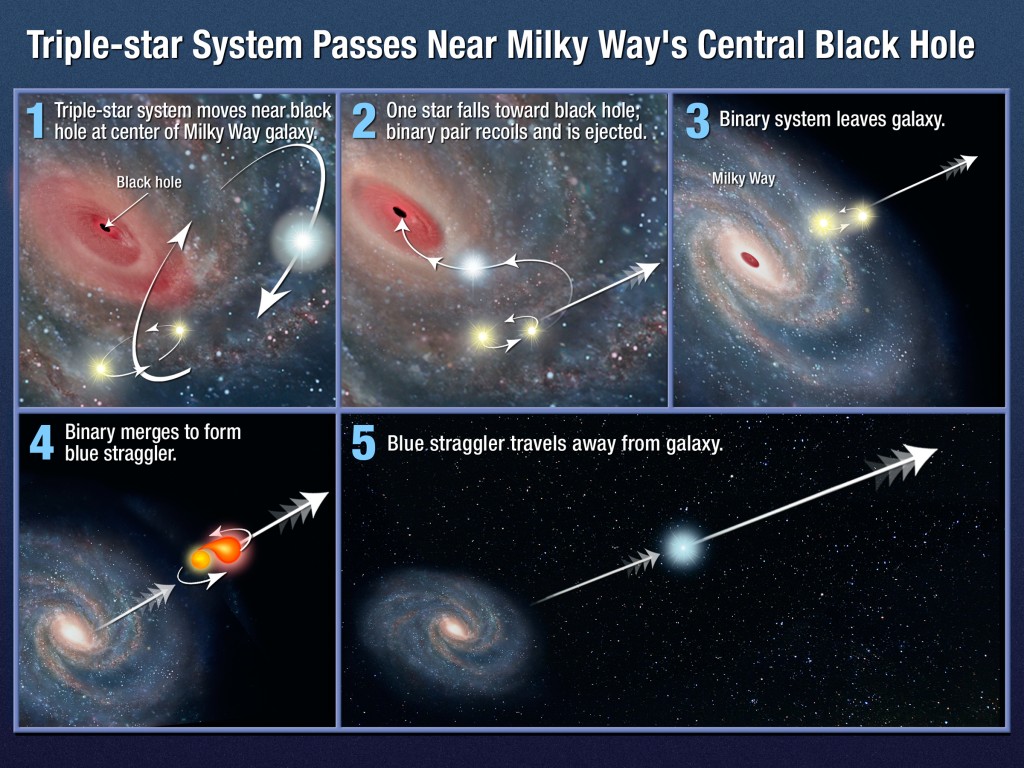[ad name=”Google Adsense 468_60″]
Bill Copeland writes:
You gotta watch this two-part video on HE 0437-5439:
- Part 1 – The Overview
- Part 2 – The Interview
It’s a totally new take on the life of stars. A happy three-some of stars danced around the Milky Way Galaxy dance club for millions of years, but they danced too close to Mr. Black Hole. He is the most attractive dancer at the center of the club, and so he stole one of the stars away from three-some. Then he kicked the other two stars out of the club.
They danced together for a long time until they merged together to make one big hot blue star. She is hot, blue, and streaking out of the Milky Way dance club to some future rendezvous out between the galaxies.
Video – Part 1 – The Overview
[kml_flashembed publishmethod=”static” fversion=”10.0.0″ useexpressinstall=”true” movie=”http://www.lecturemaker.com/scripts/lmvideov4204_lm.swf” width=”854″ height=”520″ targetclass=”flashmovie” fvars=” vidName = bchotstara_meta.flv; lecID = 1; gaFID = 2011/11/hot-star-overview/; lecSubDir = /cosmology_2011/; imgSubDir = /cosmology_2011/; imgPreLoad = LMPreloadImageHotStarA.jpg; vidWidth=854; vidHeight=480; winPtr = http://en.wikipedia.org/wiki/HE_0437-5439; winTip = More info on HE 0437-5439 from wikipedia”]
[/kml_flashembed]
Here’s the text of Part 1:
The following story is based on a publicity release from the Space Telescope Science Institute, Baltimore, Maryland, courtesy of Donna Weaver (See reference below).
The milky way is a big dance club for stars. They all dance around the most attractive member at the center, the dark and mysterious Black Hole. He exerts power over all the other stars in the Galaxy.
We recently learned that a couple of members of the club have been kicked out.
They were part of a three-some that danced together for millions of years, but even in the huge Milky Way things change. The happy three-some danced too closely to Mr. Black Hole. He reached out to grab one of them and kicked the other two out of the club.
The two danced their way out of the club and joined up they become the parents of one large super-hot blue star.
This is not science fiction. The hot blue star is one of the fastest ever detected with a speed of 1.6 million mph. That’s the speed you need to escape the Milky Way Club.
Using Hubble camera astronomers can look back down the stars path to see where she came from.
She came directly from the clutches of old Mr. Black Hole.
The stellar outcast already is cruising in the Milky Way’s distant outskirts about 200,000 light-years from the galaxy’s center.
So she’s hot, she’s blue, and she’s left the club for an unknown rendezvous way out in the dark depths of intergalactic space. We’ll keep track of her for you.
Tune in later for a report on her next encounter.
Here is a copy of the five-panel graphic of the Hyper-velocity Star history.
Video – Part 2 – The Interview
[kml_flashembed publishmethod=”static” fversion=”10.0.0″ useexpressinstall=”true” movie=”http://www.lecturemaker.com/scripts/lmvideov4204_lm.swf” width=”854″ height=”520″ targetclass=”flashmovie” fvars=” vidName = bchotstarb_meta.flv; lecID = 2; gaFID = 2011/11/hot-star-interview/; lecSubDir = /cosmology_2011/; imgSubDir = /cosmology_2011/; imgPreLoad = LMPreloadImageHotStarB.jpg; vidWidth=854; vidHeight=480; autoNavDisplay=1; navDotParam = {Introduction by Bill Copeland}{.0}, {Q 1. Would you tell us a little about yourself, Dr. Brown?}{.0633}, {Q 2. Do you just work on hyper velocity stars?}{.1048}, {Q 3. Do you actually get your hands dirty putting the equipment together?}{.1710}, {Q 4. What is a hypervelocity star?}{.1910}, {Q 5. Did a star hit the Black Hole … or did the Black Hole gobble it up?}{.2667}, {Q 6. Where did the blue star come from?}{.5385}, {Q 7. Did two stars merge to create a new star?}{.6275}, {Q 8. How old is this hot blue star?}{.7032}, {Q 9. Could the hot blue star hit the Earth?}{.8599}, {Closing remarks}{.9549}; winPtr = http://en.wikipedia.org/wiki/HE_0437-5439; winTip = More info on HE 0437-5439 from wikipedia”]
[/kml_flashembed]
Note: The red navigation dots that appear in the video player timeline match the questions listed below… You can click on these dots, or on the “go there” links next to the questions below, to jump to that specific segment in the video.
This report is the second part on a recently discovered Hot Blue Star streaking out of the Milky Way. It features an interview with Dr. Warren Brown, foremost astronomer in the field of high velocity stars ejected from our galaxy, the Milky Way.
Interview Questions:
Question 1: Thank you for joining us, Dr. Brown. Would you tell us a little about yourself and your work?
Question 2: Do you just work on hypervelocity stars or do you have other technical interests?
Question 3: Do you actually get your hands dirty putting the equipment together?
Question 4: What is a Hypervelocity star? How hard is it to find your hyper-velocity stars?
Question 5: Did a star hit the Black Hole … or did the Black Hole gobble it up?
Question 6: Where did the Blue star come from?
Question 7: Two stars merged to create a new star?
Question 8: How old is this Hot Blue Star?
Question 9: Could the Hot Blue Star hit the Earth?
Thank you very much.
References
The source for this story about the hot blue star is the following news release:
NASA’S HUBBLE SHOWS HYPERFAST STAR WAS BOOTED FROM MILKY WAY
July 22, 2010
Contacts:
J.D. Harrington
Headquarters, Washington
+1 202-358-5241
j.d.harrington@nasa.gov
Donna Weaver
Space Telescope Science Institute, Baltimore
+1 410-338-4493
dweaver@stsci.edu
Warren Brown
Harvard-Smithsonian Center for Astrophysics, Cambridge, Mass.
+1 617-496-7905
wbrown@cfa.harvard.edu
Hubble Telescope Site:
http://hubblesite.org/newscenter/archive/releases/2010/19/image/b/format/web/
NASA Hubble Mission Site:
http://www.nasa.gov/mission_pages/hubble/main/index.html
| Bill Copeland Broadcasting Photo |
 |
| www.cosmicswan.com
The five-panel graphic and description can be found at: http://www.nasa.gov/mission_pages/hubble/science/expelled-star.html |


Leave a Reply